Chapter 18 Electric Charge and Electric Field
18.5 Electric Field Lines: Multiple Charges
Summary
- Calculate the total force (magnitude and direction) exerted on a test charge from more than one charge
- Describe an electric field diagram of a positive point charge; of a negative point charge with twice the magnitude of positive charge
- Draw the electric field lines between two points of the same charge; between two points of opposite charge.
Drawings using lines to represent electric fields around charged objects are very useful in visualizing field strength and direction. Since the electric field has both magnitude and direction, it is a vector. Like all vectors, the electric field can be represented by an arrow that has length proportional to its magnitude and that points in the correct direction. (We have used arrows extensively to represent force vectors, for example.)
Figure 1 shows two pictorial representations of the same electric field created by a positive point charge [latex]{Q}[/latex]. Figure 1 (b) shows the standard representation using continuous lines. Figure 1 (b) shows numerous individual arrows with each arrow representing the force on a test charge [latex]{q}[/latex]. Field lines are essentially a map of infinitesimal force vectors.
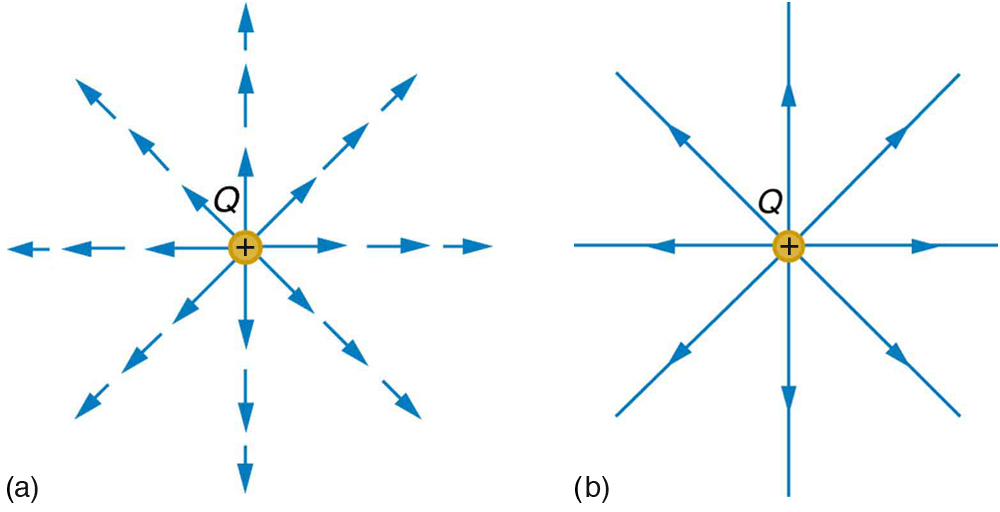
Note that the electric field is defined for a positive test charge [latex]{q}[/latex], so that the field lines point away from a positive charge and toward a negative charge. (See Figure 2.) The electric field strength is exactly proportional to the number of field lines per unit area, since the magnitude of the electric field for a point charge is [latex]{E = k|Q|/r^2}[/latex] and area is proportional to [latex]{r^2}[/latex]. This pictorial representation, in which field lines represent the direction and their closeness (that is, their areal density or the number of lines crossing a unit area) represents strength, is used for all fields: electrostatic, gravitational, magnetic, and others.
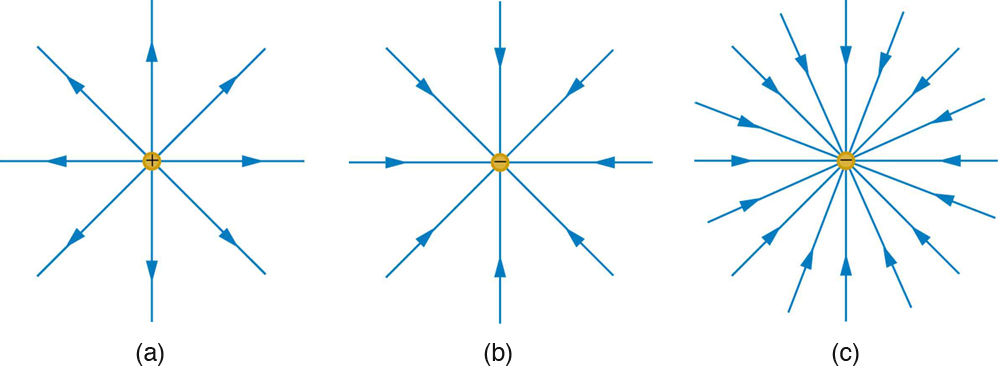
In many situations, there are multiple charges. The total electric field created by multiple charges is the vector sum of the individual fields created by each charge. The following example shows how to add electric field vectors.
Example 1: Adding Electric Fields
Find the magnitude and direction of the total electric field due to the two point charges, [latex]{q_1}[/latex] and [latex]{q_2}[/latex], at the origin of the coordinate system as shown in Figure 3.
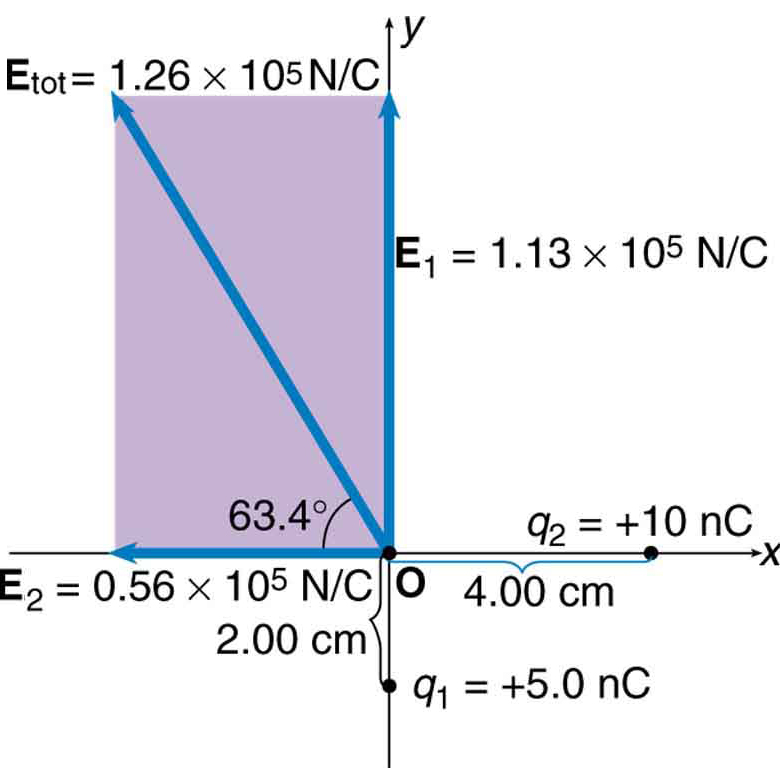
Strategy
Since the electric field is a vector (having magnitude and direction), we add electric fields with the same vector techniques used for other types of vectors. We first must find the electric field due to each charge at the point of interest, which is the origin of the coordinate system (O) in this instance. We pretend that there is a positive test charge, [latex]{q}[/latex], at point O, which allows us to determine the direction of the fields [latex]{\textbf{E}_1}[/latex] and [latex]{\textbf{E}_2}[/latex]. Once those fields are found, the total field can be determined using vector addition.
Solution
The electric field strength at the origin due to [latex]{q_1}[/latex] is labeled [latex]{E_1}[/latex] and is calculated:
Similarly, [latex]{E_2}[/latex] is
Four digits have been retained in this solution to illustrate that [latex]{E_1}[/latex] is exactly twice the magnitude of [latex]{E_2}[/latex]. Now arrows are drawn to represent the magnitudes and directions of [latex]{\textbf{E}_1}[/latex] and [latex]{\textbf{E}_2}[/latex]. (See Figure 3.) The direction of the electric field is that of the force on a positive charge so both arrows point directly away from the positive charges that create them. The arrow for [latex]{\textbf{E}_1}[/latex] is exactly twice the length of that for [latex]{\textbf{E}_2}[/latex]. The arrows form a right triangle in this case and can be added using the Pythagorean theorem. The magnitude of the total field [latex]{E_{\text{tot}}}[/latex] is
The direction is
or [latex]{63.4^{\circ}}[/latex] above the x-axis.
Discussion
In cases where the electric field vectors to be added are not perpendicular, vector components or graphical techniques can be used. The total electric field found in this example is the total electric field at only one point in space. To find the total electric field due to these two charges over an entire region, the same technique must be repeated for each point in the region. This impossibly lengthy task (there are an infinite number of points in space) can be avoided by calculating the total field at representative points and using some of the unifying features noted next.
Figure 4 shows how the electric field from two point charges can be drawn by finding the total field at representative points and drawing electric field lines consistent with those points. While the electric fields from multiple charges are more complex than those of single charges, some simple features are easily noticed.
For example, the field is weaker between like charges, as shown by the lines being farther apart in that region. (This is because the fields from each charge exert opposing forces on any charge placed between them.) (See Figure 4 and Figure 5(a).) Furthermore, at a great distance from two like charges, the field becomes identical to the field from a single, larger charge.
Figure 5(b) shows the electric field of two unlike charges. The field is stronger between the charges. In that region, the fields from each charge are in the same direction, and so their strengths add. The field of two unlike charges is weak at large distances, because the fields of the individual charges are in opposite directions and so their strengths subtract. At very large distances, the field of two unlike charges looks like that of a smaller single charge.
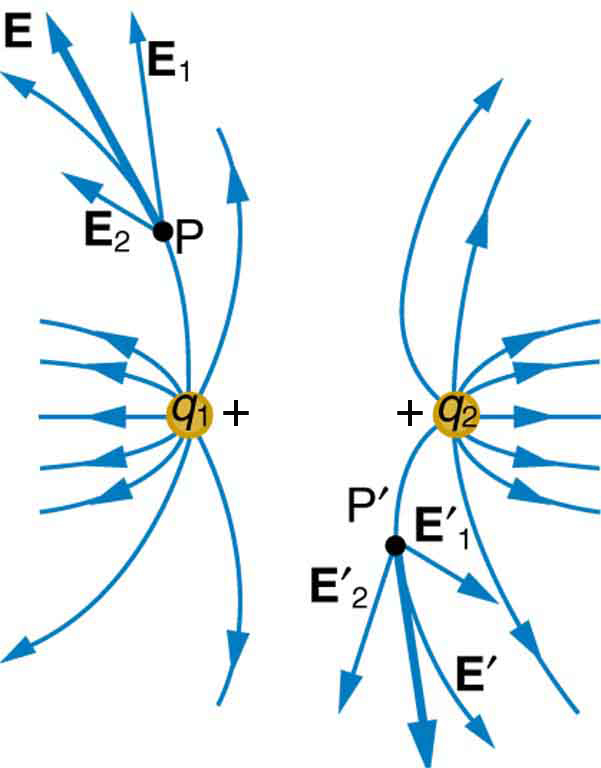
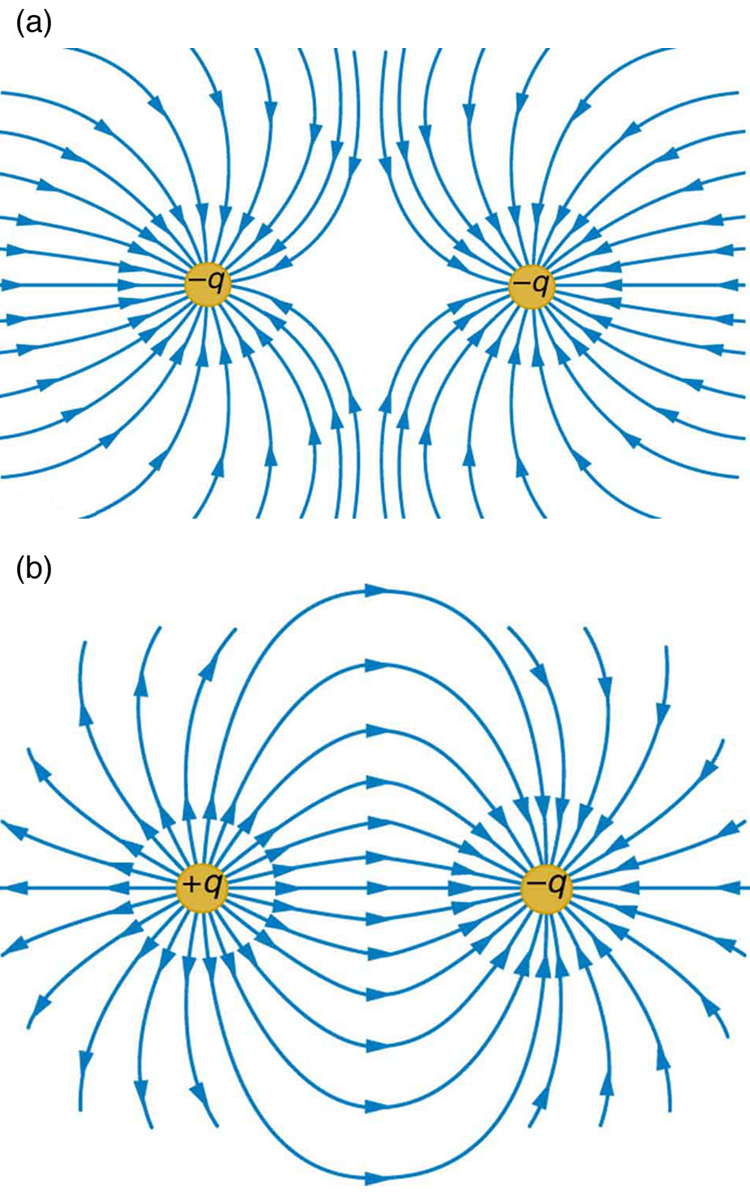
We use electric field lines to visualize and analyze electric fields (the lines are a pictorial tool, not a physical entity in themselves). The properties of electric field lines for any charge distribution can be summarized as follows:
- Field lines must begin on positive charges and terminate on negative charges, or at infinity in the hypothetical case of isolated charges.
- The number of field lines leaving a positive charge or entering a negative charge is proportional to the magnitude of the charge.
- The strength of the field is proportional to the closeness of the field lines—more precisely, it is proportional to the number of lines per unit area perpendicular to the lines.
- The direction of the electric field is tangent to the field line at any point in space.
- Field lines can never cross.
The last property means that the field is unique at any point. The field line represents the direction of the field; so if they crossed, the field would have two directions at that location (an impossibility if the field is unique).
PhET Explorations: Charges and Fields
Move point charges around on the playing field and then view the electric field, voltages, equipotential lines, and more. It’s colorful, it’s dynamic, it’s free.

Section Summary
- Drawings of electric field lines are useful visual tools. The properties of electric field lines for any charge distribution are that:
- Field lines must begin on positive charges and terminate on negative charges, or at infinity in the hypothetical case of isolated charges.
- The number of field lines leaving a positive charge or entering a negative charge is proportional to the magnitude of the charge.
- The strength of the field is proportional to the closeness of the field lines—more precisely, it is proportional to the number of lines per unit area perpendicular to the lines.
- The direction of the electric field is tangent to the field line at any point in space.
- Field lines can never cross.
Conceptual Questions
1: Compare and contrast the Coulomb force field and the electric field. To do this, make a list of five properties for the Coulomb force field analogous to the five properties listed for electric field lines. Compare each item in your list of Coulomb force field properties with those of the electric field—are they the same or different? (For example, electric field lines cannot cross. Is the same true for Coulomb field lines?)
2: Figure 7 shows an electric field extending over three regions, labeled I, II, and III. Answer the following questions. (a) Are there any isolated charges? If so, in what region and what are their signs? (b) Where is the field strongest? (c) Where is it weakest? (d) Where is the field the most uniform?
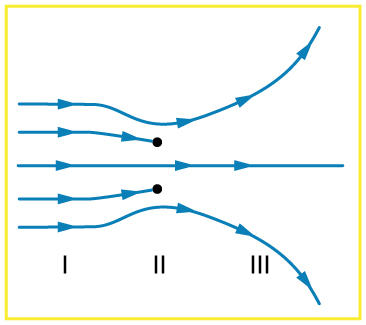
Problem Exercises
1: (a) Sketch the electric field lines near a point charge [latex]{+q}[/latex]. (b) Do the same for a point charge [latex]{-3.00q}[/latex]
2: Sketch the electric field lines a long distance from the charge distributions shown in Figure 5 (a) and (b)
3: Figure 8 shows the electric field lines near two charges [latex]{q_1}[/latex] and [latex]{q_2}[/latex]. What is the ratio of their magnitudes? (b) Sketch the electric field lines a long distance from the charges shown in the figure.
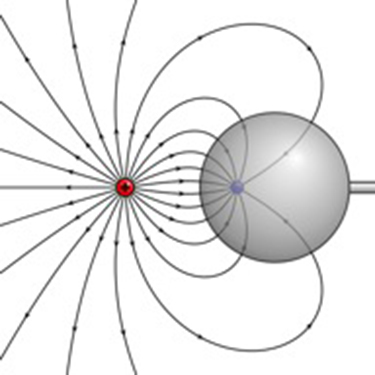
4: Sketch the electric field lines in the vicinity of two opposite charges, where the negative charge is three times greater in magnitude than the positive. (See Figure 8 for a similar situation).
Glossary
- electric field
- a three-dimensional map of the electric force extended out into space from a point charge
- electric field lines
- a series of lines drawn from a point charge representing the magnitude and direction of force exerted by that charge
- vector
- a quantity with both magnitude and direction
- vector addition
- mathematical combination of two or more vectors, including their magnitudes, directions, and positions

